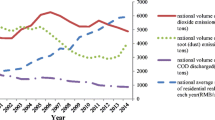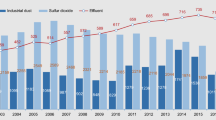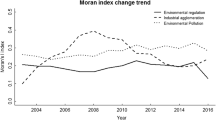Abstract
There has been a growing concern regarding the regulation of environmental pollution in the face of a growing population, global warming, and climate change. Governments around the world have devised various mechanisms and policy strategies to ameliorate the worsening condition of natural environment around the world. Similar to the developed world, in China, the government is also aware of deteriorating environmental conditions. Hence, the existing abatement instruments include pollution discharge fees and several other policy strategies. This research is conducted to investigate the association between pollution intensity and its determinants, i.e., pollutant discharge fees and urban population, third industry structure, and total retail goods consumption. The secondary data of 29 provinces is used for empirical analysis. The principal component analysis is used to develop a single index called pollution intensity, and panel autoregressive distributed lags model (ARDL), or pooled mean group (PMG) analysis, is employed to find long-run and short-run relationship. The empirical findings show that pollution discharge fees negatively affects pollution intensity. Total retail good consumption and urban population increase pollution intensity. However, third industry structure helps to control pollution intensity. These results suggest reforms in the existing environmental regulations policy by targeting more pollutant intensive provinces.
Similar content being viewed by others
Notes
List of provinces are given in Appendix 1.
PCA results are given in Appendix 2.
Figure-1A provides provincial level pollutant discharge fee in the Appendix.
Figure-3A provides provincial wise total retail goods consumption in the Appendix.
Figure-2A provides provincial wise population growth in the Appendix.
The results are available upon request from authors.
References
Abolhosseini S, Heshmati A, Altmann J (2014) The effect of renewable energy development on carbon emission reduction: an empirical analysis for the EU-15 countries. IZA DP No. 7989, February 2014
Adusah-Poku F (2016) Carbon dioxide emissions, urbanization and population: empirical evidence from Sub-Sahran Africa. Energy Econ Lett 3(1):1–16
Al-Mulali U, Saboori B, Ozturk I (2015) Investigating the environmental Kuznets curve hypothesis in Vietnam. Energy Policy 76:123–131
Almutairi H, Elhedhli S (2014) Modeling, analysis, and evaluation of a carbon tax policy based on the emission factor. Comput Ind Eng 77:88–102
Ambec S, Cohen MA, Elgie S, Lanoie P (2013) The Porter hypothesis at 20: can environmental regulation enhance innovation and competitiveness? Rev Environ Econ Policy 7(1):2–22
Asteriou D, Hall SG (2015) Applied econometrics. Macmillan International Higher Education
Asteriou D, Monastiriots V (2004) What do unions do at the large scale? Macroeconomic evidence from a panel of OECD countries. J Appl Econ 7(1):27–46
Azid A, Juahir H, Toriman ME, Kamarudin MKA, Saudi ASM, Hasnam CNC, Osman MR (2014) Prediction of the level of air pollution using principal component analysis and artificial neural network techniques: a case study in Malaysia. Water Air Soil Pollut 225(8):2063
Bello AK, Abimbola OM (2010) Does the level of economic growth influence environmental quality in Nigeria: a test of environmental Kuznets curve (EKC) hypothesis. Pak J Soc Sci 7(4):325–329
Birdsall N (1992) Another look at population and global warming (Vol. 1020). World Bank Publications
Boden T, Marland G, Andres B (2009) Global CO2 emissions from fossil-fuel burning, cement manufacture, and gas flaring: 1751–2006. Carbon Dioxide Information Analysis Center (CDIAC) Laboratory, Oak Ridge National Laboratory, Oak Ridge, Tenn., USA http://cdiac.ornl.gov/ftp/ndp030/global.1751_2006.ems.
Boutabba MA (2014) The impact of financial development, income, energy and trade on carbon emissions: evidence from the Indian economy. Econ Model 40:33–41
Burchart-Korol D, Pichlak M, Kruczek M (2016) Innovative technologies for greenhouse gas emission reduction in steel production. Metalurgija 55(1):119–122
Chandia KE, Gul I, Aziz S, Sarwar B, Zulfiqar S (2018) An analysis of the association among carbon dioxide emissions, energy consumption and economic performance: an econometric model. Carbon Manage:1–15
Charfeddine L, Khediri KB (2016) Financial development and environmental quality in UAE: cointegration with structural breaks. Renew Sust Energ Rev 55:1322–1335
Chen K, Stanway D (2016) China sets cap for energy consumption for first time. Reuters, Global Energy News, March, 4
Cherni A, Jouini SE (2017) An ARDL approach to the CO2 emissions, renewable energy and economic growth nexus: Tunisian evidence. Int J Hydrog Energy 42(48):29056–29066
Chertow MR (2000) The IPAT equation and its variants. J Ind Ecol 4(4):13–29
Clark C, Foxon T, Gross R, Jacobs M (2001) Innovation and the environment: challenges and policy options for the UK. Imperial College of Science, Technology and Medicine
Cole M (2005) Re-examining the pollution-income relationship: a random coefficients approach. Econ Bull 14(1):1–7
Cole MA, Elliott RJ, Shimamoto K (2005) Industrial characteristics, environmental regulations and air pollution: an analysis of the UK manufacturing sector. J Environ Econ Manag 50(1):121–143
Dar JA, Asif M (2018) Does financial development improve environmental quality in Turkey? An application of endogenous structural breaks based cointegration approach. Manag Environ Qual 29(2):368–384
Dasgupta, S., Wheeler, D. and Huq, M. (1997). Bending the rules: discretionary pollution control in China.
De Bruyn SM, van den Bergh JC, Opschoor JB (1998) Economic growth and emissions: reconsidering the empirical basis of environmental Kuznets curves. Ecol Econ 25(2):161–175
Dechezleprêtre, A., Martin, R. and Bassi, S. (2016). Climate change policy, innovation and growth. London: Grantham Research Institute & Global Green Growth Institute. At http://www.lse.ac.uk/GranthamInstitute/wp-content/uploads/2016/01/Dechezlepretre-et-alpolicybrief-Jan-2016.pdf.
Depuy M, Xuan W (2016) China’s string of new policies addressing renewable energy curtailment: an update. Renewable Energy World
Diallo, A. K. and Masih, M. (2017). CO2 emissions and financial development: evidence from the United Arab Emirates based on an ARDL approach.
Dietz T, Rosa EA (1997) Effects of population and affluence on CO2 emissions. Proc Natl Acad Sci 94(1):175–179
Dinda S (2004) Environmental Kuznets curve hypothesis: a survey. Ecol Econ 49(4):431–455
Engelman, R. (1994). Stabilizing the atmosphere: population consumption and greenhouse gases
Fernández YF, López MF, Blanco BO (2018) Innovation for sustainability: the impact of R&D spending on CO2 emissions. J Clean Prod 172:3459–3467
Friedl B, Getzner M (2003) Determinants of CO2 emissions in a small open economy. Ecol Econ 45(1):133–148
Fromentin V (2017) The long-run and short-run impacts of remittances on financial development in developing countries. Q Rev Econ Finance 66:192–201
Galeotti M, Lanza A, Pauli F (2006) Reassessing the environmental Kuznets curve for CO2 emissions: a robustness exercise. Ecol Econ 57(1):152–163
Gao Y, Tsai SB, Xue X, Ren T, Du X, Chen Q, Wang J (2018) An empirical study on green innovation efficiency in the green institutional environment. Sustainability 10(3):724
Georg S, Røpke I, Jørgensen U (1992) Clean technology—Innovation and environmental regulation. Environ Resour Econ 2(6):533–550
Gokmenoglu K, Ozatac N, Eren BM (2015) Relationship between industrial production, financial development and carbon emissions: the case of Turkey. Procedia Econ Financ 25:463–470
Greene WH (2003) Econometric analysis. Pearson Education India
Grossman GM, Krueger AB (1995) Economic growth and the environment. Q J Econ 110(2):353–377
Gujarati, D. N. (2009). Basic econometrics: Tata McGraw-Hill Education.
Guo X, Ho MS, You L, Cao J, Fang Y, Tu T, Hong Y (2018) Industrial water pollution discharge taxes in China: a multi-sector dynamic analysis. Water 10(12):1742
Harris R, Tzavalis E (1996) Inference for unit roots in dynamic panels (No. 9604)
Hettige H, Huq M, Pargal S, Wheeler D (1996) Determinants of pollution abatement in developing countries: evidence from South and Southeast Asia. World Dev 24(12):1891–1904
Holtz-Eakin D, Selden TM (1995) Stoking the fires? CO2 emissions and economic growth. J Public Econ 57(1):85–101
Im KS, Pesaran MH, Shin Y (2003) Testing for unit roots in heterogeneous panels. J Econ 115(1):53–74
Jaffe AB, Palmer K (1997) Environmental regulation and innovation: a panel data study. Rev Econ Stat 79(4):610–619
Jaffe AB, Peterson SR, Portney PR, Stavins RN (1995) Environmental regulation and the competitiveness of US manufacturing: what does the evidence tell us? J Econ Lit 33(1):132–163
Jalil A, Feridun M (2011) The impact of growth, energy and financial development on the environment in China: a cointegration analysis. Energy Econ 33(2):284–291
Jamel L, Maktouf S (2017) The nexus between economic growth, financial development, trade openness, and CO2 emissions in European countries. Cogent Econ Financ 5(1):1341456
Jin L, Duan K, Shi C, Ju X (2017) The impact of technological progress in the energy sector on carbon emissions: an empirical analysis from China. Int J Environ Res Public Health 14(12):1505
Jordaan SM, Romo-Rabago E, McLeary R, Reidy L, Nazari J, Herremans IM (2017) The role of energy technology innovation in reducing greenhouse gas emissions: a case study of Canada. Renew Sust Energ Rev 78:1397–1409
Kang Y-Q, Zhao T, Yang Y-Y (2016) Environmental Kuznets curve for CO2 emissions in China: a spatial panel data approach. Ecol Indic 63:231–239
Kanjilal K, Ghosh S (2013) Environmental Kuznet’s curve for India: Evidence from tests for cointegration with unknown structuralbreaks. Energy Policy 56:509–515
Kemp R, Pontoglio S (2011) The innovation effects of environmental policy instruments—a typical case of the blind men and the elephant? Ecol Econ 72:28–36
Kivyiro P, Arminen H (2014) Carbon dioxide emissions, energy consumption, economic growth, and foreign direct investment: Causality analysis for Sub-Saharan Africa. Energy 74:595–606
Komal R, Abbas F (2015) Linking financial development, economic growth and energy consumption in Pakistan. Renew Sust Energ Rev 44:211–220
Lee K-H, Min B, Yook K-H (2015) The impacts of carbon (CO2) emissions and environmental research and development (R&D) investment on firm performance. Int J Prod Econ 167:1–11
Li Z, Zhao J (2017) Environmental effects of carbon taxes: a review and case study. World J Soc Sci 4(2):7
Liu Y, Yan B, Zhou Y (2016) Urbanization, economic growth, and carbon dioxide emissions in China: a panel cointegration and causality analysis. J Geogr Sci 26(2):131–152
Ma Y, Hou G, Xin B (2017) Green process innovation and innovation benefit: the mediating effect of firm image. Sustainability 9(10):1778
Maddala GS, Wu S (1999) A comparative study of unit root tests with panel data and a new simple test. Oxf Bull Econ Stat 61(S1):631–652
Managi S, Jena PR (2008) Environmental productivity and Kuznets curve in India. Ecol Econ 65(2):432–440
Managi S, Kaneko S (2009) Environmental performance and returns to pollution abatement in China. Ecol Econ 68(6):1643–1651
Martínez-Zarzoso I, Bengochea-Morancho A (2004) Pooled mean group estimation of an environmental Kuznets curve for CO2. Econ Lett 82(1):121–126
Martínez-Zarzoso I, Maruotti A (2011) The impact of urbanization on CO2 emissions: evidence from developing countries. Ecol Econ 70(7):1344–1353
McCleary GF (1953) The Malthusian population theory. Faber & Faber, London
Meyerson FA (1998) Population, carbon emmissions, and global warming: the forgotten relationship at Kyoto. Popul Dev Rev 24:115–130
Moomaw WR, Unruh GC (1997) Are environmental Kuznets curves misleading us? The case of CO2 emissions. Environ Dev Econ 2(4):451–463
Mu Z, Bu S, Xue B (2014) Environmental legislation in China: achievements, challenges and trends. Sustainability 6(12):8967–8979
Nasreen S, Anwar S, Ozturk I (2017) Financial stability, energy consumption and environmental quality: evidence from South Asian economies. Renew Sust Energ Rev 67:1105–1122
Pesaran MH, Smith R (1995) Estimating long-run relationships from dynamic heterogeneous panels. J Econ 68(1):79–113
Pesaran MH, Shin Y, Smith RP (1999) Pooled mean group estimation of dynamic heterogeneous panels. J Am Stat Assoc 94(446):621–634
Ponce d LBD, Marshall J (2014) Relationship between urbanization and CO2 emissions depends on income level and policy. Environ Sci Technol 48(7):3632–3639
Press CS (2016) China Statistical Yearbook 2016
Sadorsky P (2009) Renewable energy consumption and income in emerging economies. Energy Policy 37(10):4021–4028
Sadorsky P (2010) The impact of financial development on energy consumption in emerging economies. Energy Policy 38(5):2528–2535
Săndică A-M, Dudian M, Ştefănescu A (2018) Air pollution and human development in Europe: a new index using principal component analysis. Sustainability 10(2):312
Scrimgeour F, Oxley L, Fatai K (2005) Reducing carbon emissions? The relative effectiveness of different types of environmental tax: the case of New Zealand. Environ Model Softw 20(11):1439–1448
Sehrawat M, Giri A, Mohapatra G (2015) The impact of financial development, economic growth and energy consumption on environmental degradation: evidence from India. Manag Environ Qual 26(5):666–682
Selden TM, Song D (1995) Neoclassical growth, the J curve for abatement, and the inverted U curve for pollution. J Environ Econ Manag 29(2):162–168
Shaari MS, Abdullah DNC, Alias NS, Adnan NSM (2016) Positive and negative effects of research and development. Int J Energy Econ Policy 6(4)
Shafik, N. (1994). Economic development and environmental quality: an econometric analysis. Oxford Economic Papers, 757-773.
Shahbaz M, Solarin SA, Mahmood H, Arouri M (2013) Does financial development reduce CO2 emissions in Malaysian economy? A time series analysis. Econ Model 35:145–152
Shen W, Wang Y (2017) Adaptive policy innovations and the construction of emission trading schemes in China: taking stock and looking forward. Environmental Innovation and Societal Transitions
Solarin, S. A., Al-Mulali, U., Gan, G. G. G. and Shahbaz, M. (2018). The impact of biomass energy consumption on pollution: evidence from 80 developed and developing countries. Environmental Science and Pollution Research, 1-17.
Stern DI (2004) The rise and fall of the environmental Kuznets curve. World Dev 32(8):1419–1439
Tamazian A, Rao BB (2010) Do economic, financial and institutional developments matter for environmental degradation? Evidence from transitional economies. Energy Econ 32(1):137–145
Tamazian A, Chousa JP, Vadlamannati KC (2009) Does higher economic and financial development lead to environmental degradation: evidence from BRIC countries. Energy Policy 37(1):246–253
Wan XY (2018) An empirical analysis of the relationship between urbanization and fiscal policy---taking Jiangxi Province of China as an example. J Math Res 10(2):140
Wang, H. and Chen, M. (1999). How the Chinese system of charges and subsidies affects pollution control efforts by China’s top industrial polluters (Vol. 2198): World Bank Publications.
Wang S, Ma H, Zhao Y (2014) Exploring the relationship between urbanization and the eco-environment—a case study of Beijing–Tianjin–Hebei region. Ecol Indic 45:171–183
Xiao B, Niu D, Guo X, Xu X (2015) The impacts of environmental tax in China: a dynamic recursive multi-sector CGE model. Energies 8(8):7777–7804
Xing T, Jiang Q, Ma X (2017) To facilitate or curb? The role of financial development in China’s carbon emissions reduction process: a novel approach. Int J Environ Res Public Health 14(10):1222
Xu B, Lin B (2017) Does the high–tech industry consistently reduce CO2 emissions? Results from nonparametric additive regression model. Environ Impact Assess Rev 63:44–58
Yang X, Li R (2018) Investigating low-carbon city: empirical study of Shanghai. Sustainability 10(4):1054
Yearbook CS (2017) National Bureau of Statistics of the People’s Republic of China 2014
Zhang Y-J (2011) The impact of financial development on carbon emissions: an empirical analysis in China. Energy Policy 39(4):2197–2203
Zhang X-P, Cheng X-M (2009) Energy consumption, carbon emissions, and economic growth in China. Ecol Econ 68(10):2706–2712
Zhang C, Lin Y (2012) Panel estimation for urbanization, energy consumption and CO2 emissions: a regional analysis in China. Energy Policy 49:488–498
Author information
Authors and Affiliations
Corresponding author
Additional information
Responsible editor: Philippe Garrigues
Publisher’s note
Springer Nature remains neutral with regard to jurisdictional claims in published maps and institutional affiliations.
Rights and permissions
About this article
Cite this article
Khan, Z., Shahbaz, M., Ahmad, M. et al. Total retail goods consumption, industry structure, urban population growth and pollution intensity: an application of panel data analysis for China. Environ Sci Pollut Res 26, 32224–32242 (2019). https://doi.org/10.1007/s11356-019-06326-0
Received:
Accepted:
Published:
Issue Date:
DOI: https://doi.org/10.1007/s11356-019-06326-0







